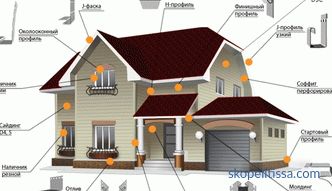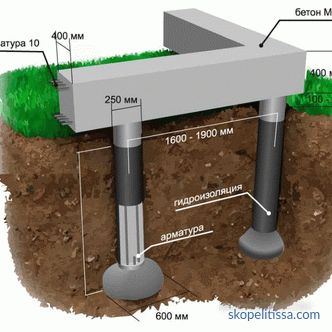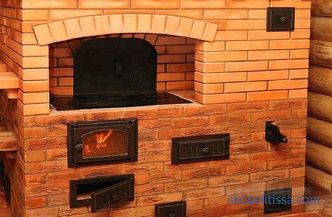The foundation is the foundation of a building that determines its durability. Strict requirements are always placed on the quality of the foundation, so the technologies used are constantly being improved. In recent decades, individual construction has been developing steadily. Often a rational choice is a pile-screw foundation, the pros and cons of which are interesting for future homeowners.
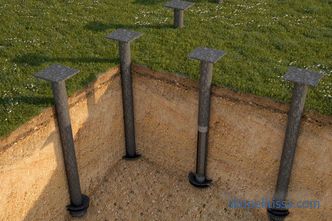
General description
The main part of such a foundation is a screw pile, which represents a steel pipe to which sharp tips with a thread, with blades or without them, are welded. The tips are used with standard or combined threads, which significantly increases the bearing area. Outwardly, they resemble screws of enormous size.
Piles are installed deep into the soil by screwing in, manually or automatically. Strongly clamped by dense layers of soil, they are firmly fixed in one position, which guarantees the stability of the whole structure. In highly mobile soils, piles with thread throughout their length are used.
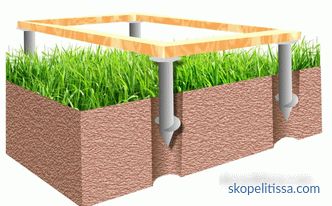
The presence of blades provides greater soil compaction, which affects the reliability of the foundation. Piles with blades are distributed at a higher price, but allow you to get the best result.
Recommendations when choosing a foundation
The feasibility of building a foundation on piles, the pros and cons of the resulting construction depend on many factors.
Construction on screw piles
The pile-screw base is not suitable for buildings made of brick, concrete or reinforced concrete blocks. The stationary building will gradually collapse due to the uneven shrinkage of the foundation in the ground. Count on his long century is not necessary.
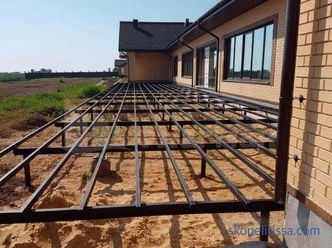
This type of foundation is ideal for light-weight frame, frame-shield or wooden buildings that have certain mobility.
Having a house on a pile and screw foundation, you can easily make an extension. This is convenient when you made a mistake with the layout or initially there was not enough money to build a larger building.
Soil requirements
For some types of soil, it is recommended that the pile-screw type of foundation. It is suitable for almost all types, except for coarse rock. It is preferable on sandy, loamy or marshy areas on which it is impossible to establish a strip foundation.
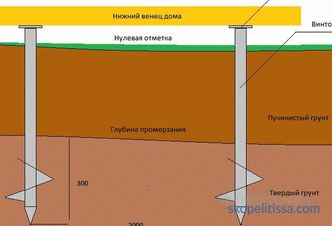
On our site you can find contacts of construction companies that offer the service of repair and design of the foundation. Directly to communicate with representatives, you can visit the exhibition of houses "Low-rise Country".
Process speed
If it is necessary to build a building in a short time, a pile foundation is the best choice. Firstly, the foundation itself is quickly and easily erected. Secondly, after its implementation there is no need to expect final approval and shrinkage, as with concrete technology, which will require to suspend work for about a month. Immediately after organizing the foundation, you can proceed to the construction of walls.
Like any other foundation, screw piles have advantages and disadvantages that cannot be ignored when using such a foundation for the construction of a dwelling house.
Advantages of the technology
The technology is quite simple, several people who have the skills of such work can perform all the steps. Experienced craftsmen need only a couple of days to build a foundation for a small building.
The process does not require serious excavation, as well as the use of:
- large vehicles for the delivery of materials;
- specialized installations for mixing concrete mix.
As a rule, lumber is used for tying up piling construction, the installation of which is also not complicated.
The installation technology of screw piles allows you to work during the cold season. Special calculations are carried out, which determine the depth of the pile piling in a particular area, it should be below the level of soil freezing. Sufficient soil resistance to heaving in frost at an estimated depth allows the installation of screw piles in the ground at this time.
A few more pluses
Evaluating the foundation on screw piles, its minuses and advantages, it should be said that the number of positive factors is much greater than the number of negative factors. The clear advantages explain the growing popularity of screw piles in private construction:
- The admissibility of the organization on moving soils or complex-relief surfaces. Can be installed on a site with a slope of up to 8 m.
- Save time and money.The cost of materials and work for the pile-screw foundation is 5 times less compared to the tape analogue, and 3 times relatively tiled (for buildings of the same area).
- Ability to get a dry and warm floor without additional work. The building built on stilts is located above ground level, which protects against moisture penetration, prevents rotting of the floor.
At the same time, the foundation on piles does not lose to the concrete foundation over the service life. Built according to the rules construction will last at least 50 years.
Disadvantages
Despite numerous advantages, there are several disadvantages that need to be taken into account:
- Difficulties in organizing a basement room. It is clear that the design features do not imply the presence of side walls, so the device basement will require additional work and funds.
- Not suitable for highlands. Stone soil will not allow piles to penetrate to the required depth.
- Experienced experts believe that such a foundation is suitable for strengthening only single-storey frame structures.
There can be more negative moments if the calculated, construction works are wrong, as well as low-quality materials are used.
Read more about the advantages and disadvantages of the pile-screw foundation described in this video:
How to choose the piles
It is important to consider a number of factors:
- the presence and quality of the anti-corrosion coating, which determines the period of operation;
- welded weld penetration to the full depth, it keeps the pipe from rupture when embedded in the ground.
Some manufacturers in order to reduce the cost of their goods save on coating, materials for welding.
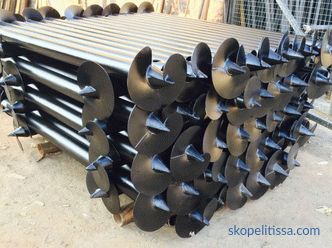
In specialized organizations, calculations are made to determine the exact size and number of piles, taking into account local soil. For private facilities, pipes with a length of up to 3 meters and a diameter of 57-133 mm are mainly used.
It may be interesting! In the article on the following link read about the reconstruction of the foundation with screw piles.
Nuances of the process
The technology of construction of houses on screw piles does not stand still and is used throughout the world. Only taking into account all the features of the foundation of screw piles, the pros and cons of its construction, it is possible to obtain a qualitative result:
- It is necessary to correctly calculate the exact length of pipes depending on the type of soil, the depth of its freezing in winter, the size of snow masses
- To achieve the necessary deepening of piles with the help of special equipment or manually, this requires at least 2 people.
- Piles must enter the ground strictly vertically.
- For greater stability, it is recommended to pour concrete into the cavity of the pipe.
- Combining detached piles with a grillage increases stability when heaving the soil in extreme cold. Rostverk is a reinforcement of the upper part of the foundation, which evenly distributes the load on all piles.
- For wooden houses, pipes are installed every 2-2.5 m. Assuming the use of heavier materials, they maintain a distance of 1.5-2 m.
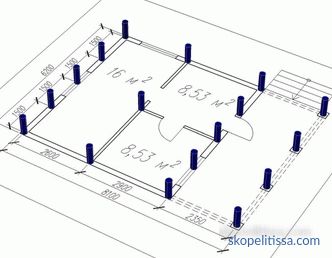
Some experts do not advise building a residential house on a pile-screw foundation, considering it more suitable for small country houses and outbuildings. But practice proves that the foundation, performed according to all the rules, is a reliable basis for sufficiently massive houses.
Comparison with other options
Only knowing all the advantages and disadvantages of the pile-screw structure, as well as the peculiarities of the tape foundations with the pluses and minuses of the technology of erection and operation of a building strengthened on it, you can make the right choice . The tape base is characterized by:
- the possibility of shallow laying on dry, not amenable to heaving soils;
- convenient arrangement of the burial space;
- the ability to do everything with your own hands;
- it takes a certain time to completely cure the concrete solution;
- is used to strengthen brick and concrete buildings;
- a significant increase in costs for areas with strong soil freezing.
It should be noted that the arrangement of the strip base during the cold season is accompanied by an increase in labor intensity and means.
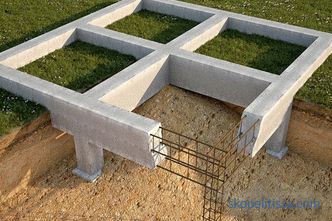
There are several other types of foundations based on the use of piles, which are popular in individual construction.
Pile-and-tape construction
The most advanced option is considered to be a pile-foundation, the advantages and disadvantages of which reflect its effectiveness in the most difficult cases:
- for a brick building or reinforced concrete structures;
- mobile heaving soils;
- ground waters, high humidity;
- difficult terrain, presence of a slope.

The piles are installed to a depth of 2.5 m, which provides increased reliability and stability foundation of the house.
Piles of reinforced concrete
Construction of a house in areas with problem soil, including coastal zones, steep slopes, peat bogs, and deep freezing, is carried out on a foundation on concrete piles, the pros and cons are as follows:
- design works are complex and must be performed by a professional;
- allows you to get the maximum possible stability and rigidity of the foundation;
- suitable for heavy buildings;
- high cost materials and works;
- use of specialized equipment.

The length of reinforced concrete piles reaches 11 meters. In private construction, elements are used about 3 m long, which weigh not less than 700 kg.
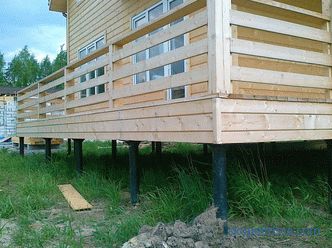
It might be interesting! In the article the following link read about repairing the foundation of a country house.
Conclusion
Considering all the options listed above, we can conclude: a screw foundation is ideal for frame construction: the pros and cons, the price of work and materials are in an optimal ratio. But the final decision should be made after a thorough study of the soil, its composition, structure and depth of freezing.
